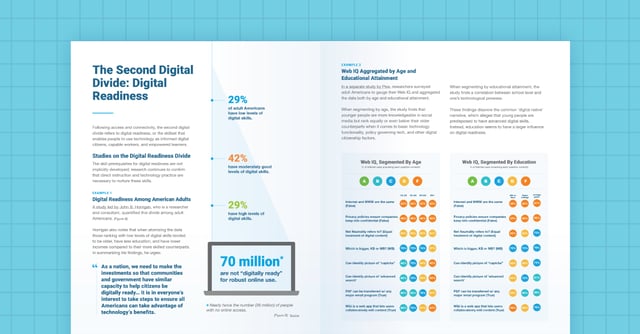The Digital Equity Basics: What It Is & Why It Matters
 Insights By Anna McVeigh-Murphy
Insights By Anna McVeigh-Murphy
By reconsidering digital equity and how it relates to larger notions of equity in education, teachers, administrators, and leaders bolster their efforts to prepare all students for the future. Indeed, equity typifies the aspiration of what it means to educate: equipping students with the knowledge and skills they will need to excel in their future.
This future can entail a lot of things, including:
- Entering the workforce and accessing stable employment.
- Supporting a family and serving as a role model for the next generation.
- Participating as an active citizen and upholding democratic values.
- Welcoming neighbors and investing in community.
- Recognizing common humanity and participating as a global citizen.
- Collaborating with diverse groups of people to seek solutions to local, national, and global problems.
- Sowing bright and sustainable futures for generations to come.
Thus, the purpose of education is not only to benefit the educated by supporting them in all aspects of their life but also to benefit the community, both local and global, of the educated.
Of course, this is an idealistic view of education; and the current reality often does not rise to meet it, leaving us to grapple with possible solutions—many of which are founded on digital equity.
What is Digital Equity?
Equity is a necessarily evolving concept because the outputs of educational equity are contingent upon the world in which the educated exist. In present circumstances with fast accelerating technological advancements and a migration toward digital mediums for work, collaboration, community, and citizenship, equity must to a large extent be digital.
The following data illustrates how technology impacts daily experiences.
Work Life: Nearly all Fortune 500 companies post job openings exclusively online and over 80 percent of all jobs require digital skills.
Academic Life: A federal survey found that 70 percent of teachers assign homework online. Many teachers also post grades online, offer feedback to students, answer questions, and address parents through digital platforms.
Personal Life: Seventy percent of Americans use social media, spending on average two hours per day using it, which means they are building online communities, sharing life updates, and engaging with news and other informational outlets.
Citizenry Life: Over 35 percent of US citizens prefer to access news online, with 20 percent using social media as a primary news source. Unable to navigate the virality of false or misleading news, only 26 percent of adults were able to correctly discern between factual and fictitious statements.
Without digital inclusion, the predominance of technology becomes a barrier to entry and participation. By working to curb this, digital equity sets out to ensure everyone has the technological capacity to participate in the labor market as empowered employees, partake in educational opportunities, engage positively with others online, and practice informed citizenship.
What Are the Digital Divides?
The road to understanding digital equity and the barriers both necessitating and inhibiting it is paved by the circumstances of inequity. In other words, the barriers to digital equity, which are commonly termed divides or digital divides, shape our understanding of it.
While the divides are framed in the context of digital equity, they rarely are purely digital in nature. Instead, they are affixed with preexisting conditions of inequity and inequality that are simply mutating with a modern, digital outlook.
In order to address the underlying forces of these divides, solutions must be systemic, holistic, and community driven. In the following articles, we define, quantify, and analyze four specific digital divides; consider their separate enacted and proposed solutions; and feature educators overcoming each divide:
- The Access and Connectivity Divide
- The Digital Readiness Divide
- The Digital Use Divide
- The Representation Divide




